ISO Certified Translation: What to Know

There is a great deal of complication concerning just what accredited translation implies, a topic we attended to in a previous blog post. Yet a visitor lately inquired about the distinction in between a certified translation and also ISO licensed translation, so we wished to seize the day to clear up the problem.
A certified translation is a translation–– typically of an official document–– gone along with by a signed declaration by the translator or translation firm attesting to that the translation is a real as well as precise rendition of the resource record. Primarily, the translation business attests that the qualified translation is a literal word-for-word translation which nothing has actually been included, erased or modified. At Translation Cloud, we take this signed statement or “certification of accuracy” extremely seriously. Occasionally, clients ask us making changes to a qualified translation, like putting words or re-arranging the message in such a way that the initial significance is changed, which is completely verboten. We understand that licensed translations are often sent as proof to a law court or regulative firm like the FDA, and also we absolutely do not wish to endanger our track record or our customer’s — — or ask our translator’s to dedicate perjury — — just to please a customer. Most of our customers appreciate this, and also know that honesty and also sincerity should be the foundation of any service connection.
ISO-certified translation is something various entirely. Translation Cloud–– together with a variety of various other translation business–– is ISO 9001:2008 licensed. That suggests our high quality monitoring system satisfies global standards that are investigated by an outdoors firm to guarantee compliance. Our translation procedures are ISO-certified, and this holds true whether we are preparing a licensed translation, a medical translation, or a license translation. When we prepare a licensed translation, the crucial distinction is the authorized certification that goes along with the translation, and our watchfulness in making sure that the translation is 100% exact and also in no chance leavings from the initial text. Certainly when we prepare a non-certified translation of a pamphlet, website, or comparable products, an actual translation is not only unnecessary yet counter-productive.




